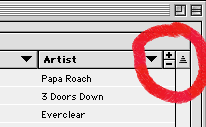I just discovered a new interaction element in SoundJam for the Mac. I’m calling it the “column control”:

Clicking the plus sign gives you one more column of information (like album, artist, time, date, size, etc.) and clicking the minus sign gives you one less. This is different than making the window bigger to expose more columns, which doesn’t happen; the window simply gets bigger. So you can have lots of columns in a compact space if you’re an information slut, or fewer columns for a minimalist approach. You can then change any column to display any category of information, and use the first column to sort by any of those categories.
In other apps I’d think it was overkill, but in this case people may keep long lists of mp3s and may want a variety of ways to sort, view, and play them.
The size of the controls, though small, is sufficient IMO since I don’t think people will be using this control often. It’s one of those things that could almost live in preferences, but some folks may want more frequent or immediate access to it. But it’s taken me months to even notice it, wonder if anyone else does?
